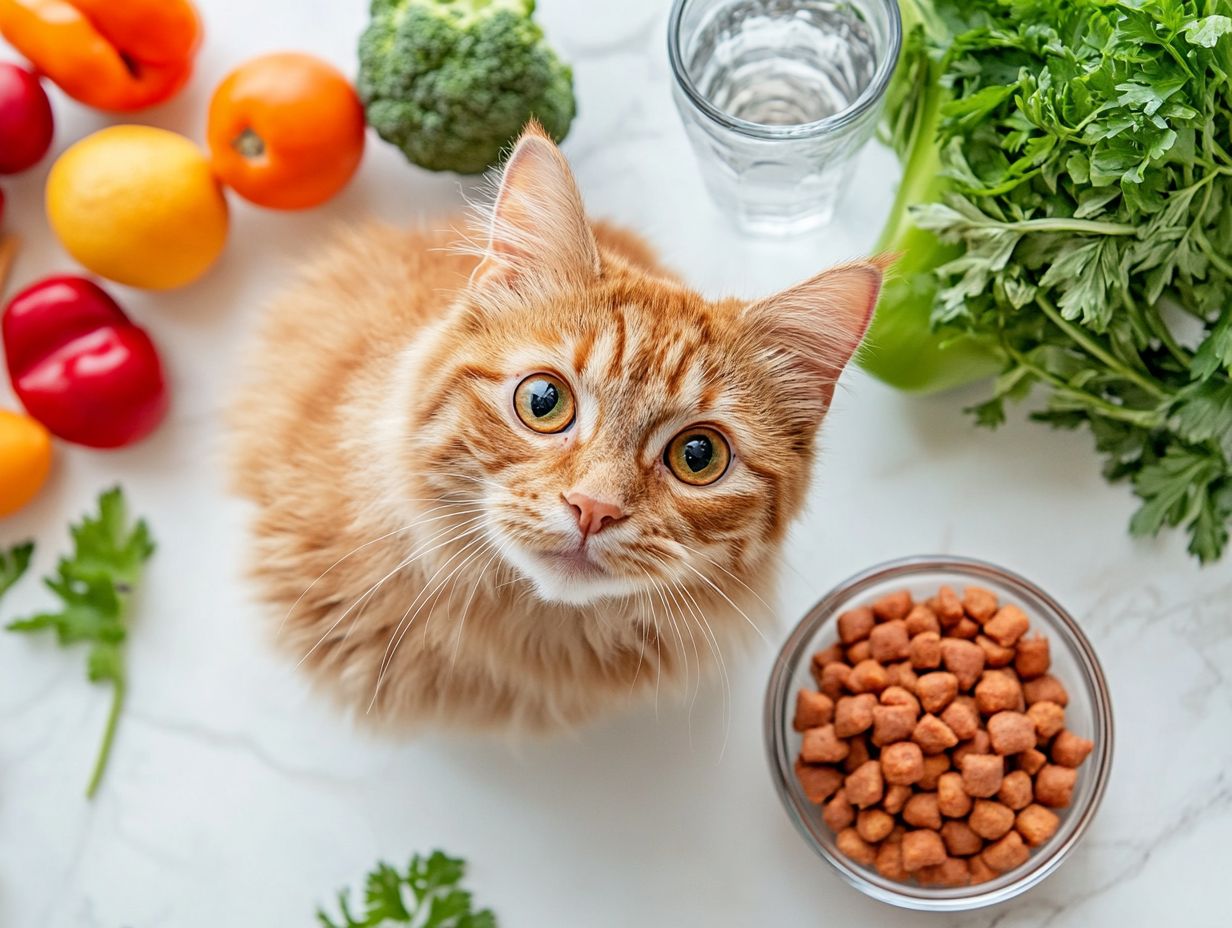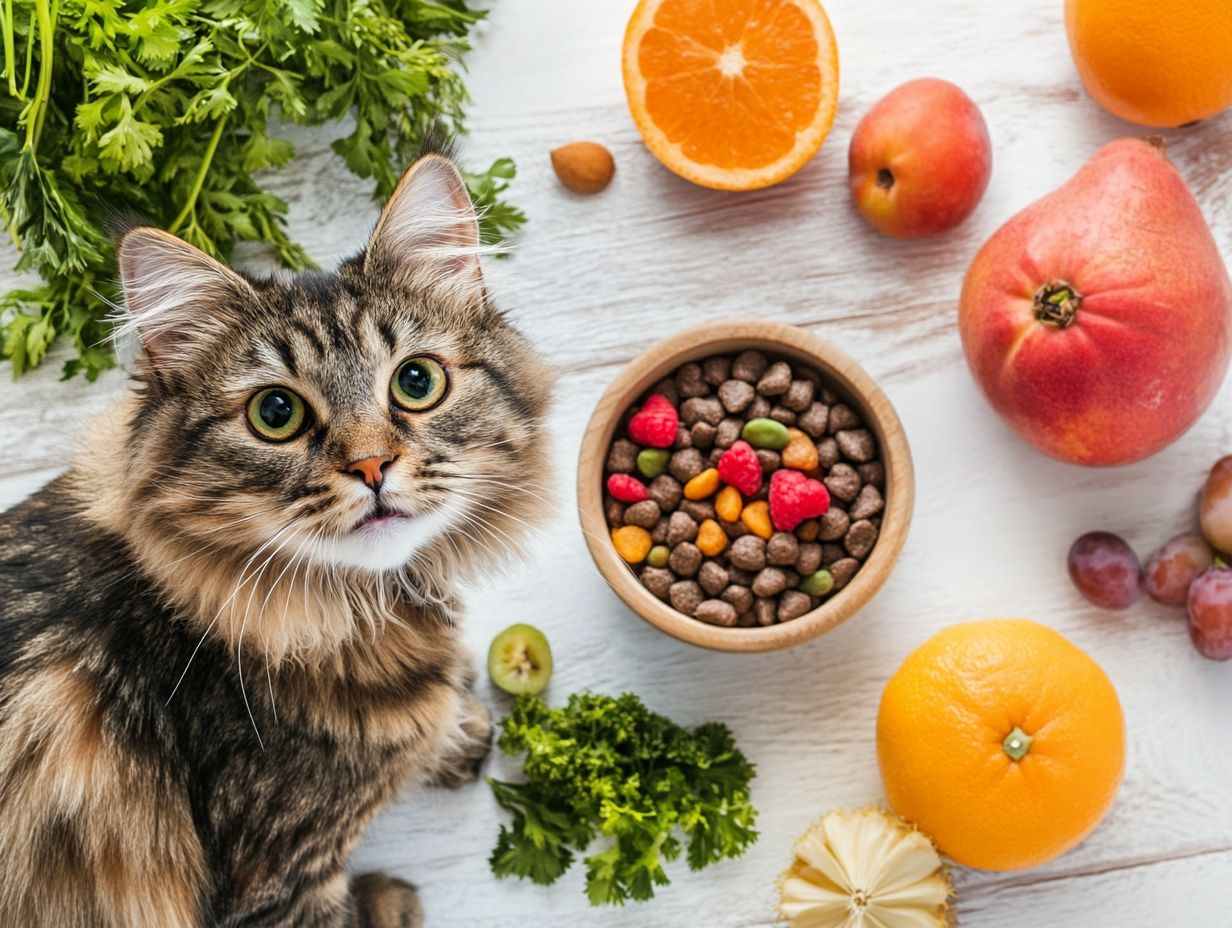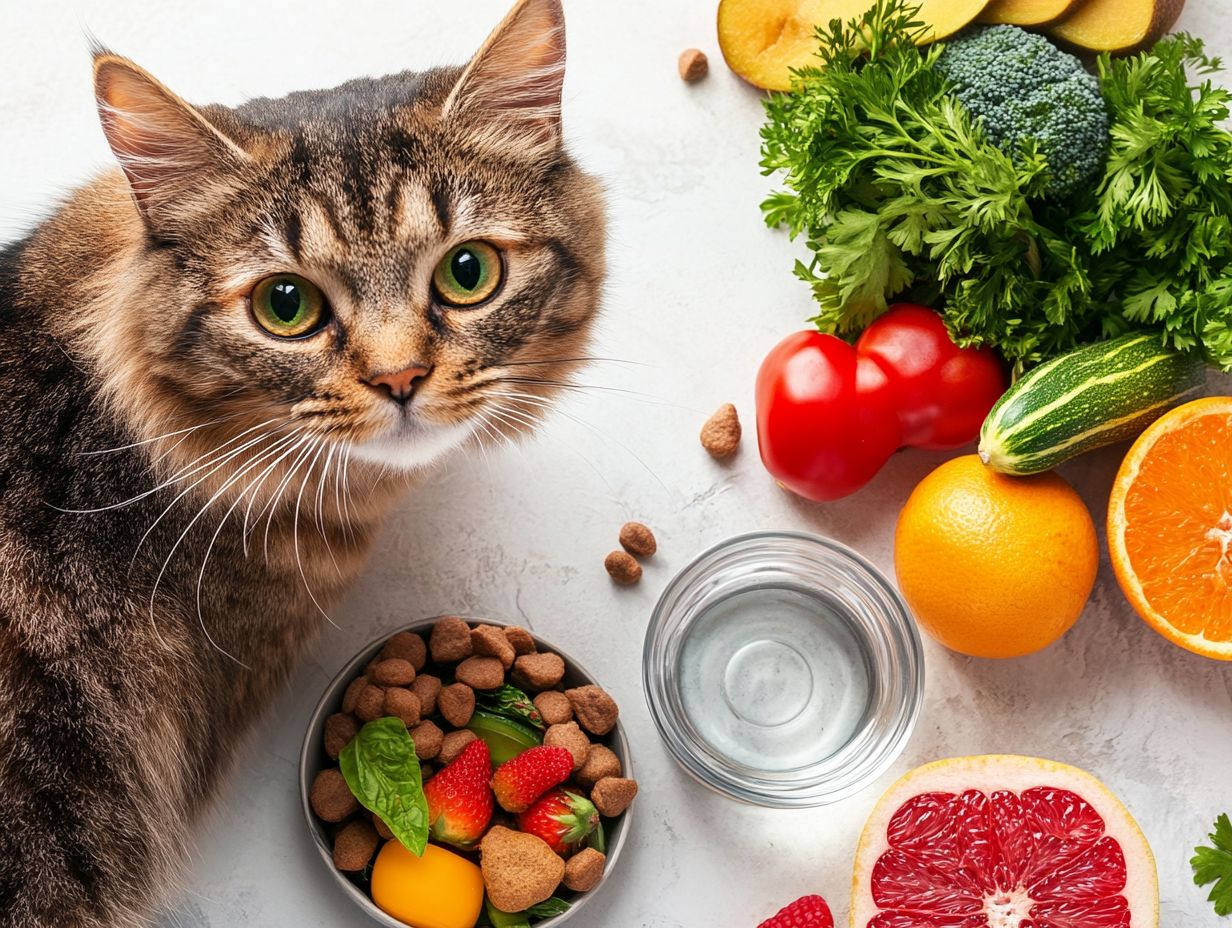Keeping your cat healthy involves understanding the intricacies of their diet, proper nutrition, and hydration.
This article explores the importance of hydration for cats, especially in the context of a raw food diet, and how feeding habits can affect their hydration needs.
We discuss the benefits and risks associated with feeding your feline a raw diet, including the necessary nutrients and caloric density, how it impacts their hydration levels, and what signs to look for in case of dehydration.
Additionally, find practical tips to ensure your kitty stays hydrated, including the use of water fountains and offering treats for cats like tuna or chicken broth, ensuring they enjoy their meals.
Join us as we uncover the essentials of feline nutrition and hydration, considering factors like proper protein levels and the role of animal nutritionists!
Key Takeaways:

Why is Hydration Important for Cats?
Hydration is essential for cats, significantly influencing their overall health and well-being. As obligate carnivores, cats require diets rich in animal products, such as canned food and semi-moist food, which directly affect their hydration needs.
Inadequate water intake can elevate a cat’s risk of dehydration, potentially leading to serious health issues such as kidney failure, kidney disease, and Feline Lower Urinary Tract Disease. Therefore, it is crucial for pet owners to recognize the importance of hydration in ensuring their cats lead a healthy life.
What is a Raw Food Diet for Cats?
A raw food diet for cats consists of a blend of uncooked animal products that closely resembles their natural diets while providing the necessary nutrients for optimal feline health. These diets are typically high in protein and protein level, and cat owners have the option to either prepare homemade meals or choose commercially prepared diets that adhere to the nutritional standards established by organizations such as the Association of American Feed Control Officials (AAFCO). This ensures that cats receive the proper nutrition they need.
What are the Benefits of a Raw Food Diet for Cats?
The benefits of a raw food diet for cats include increased moisture intake, increased protein intake, and enhanced overall health. This diet closely mimics the natural feeding patterns of cats’ ancestors, which primarily consisted of high-protein animal products.
When balanced properly, a raw food diet can significantly enhance the quality of life for these obligate carnivores by improving their physical health. Many cat owners have reported notable improvements in digestion and coat condition, which, in turn, have reduced issues with fur shedding and skin irritations.
Additionally, allergy symptoms have diminished for several owners, suggesting that this diet may benefit cats sensitive to commercial foods. The moisture-rich composition of raw ingredients also meets cats’ hydration needs.
By adhering to this nutritional approach, caregivers can help their cats thrive, ultimately contributing to a longer and healthier life.
What are the Risks of a Raw Food Diet for Cats?
The risks associated with a raw food diet for cats include nutritional deficiencies, foodborne illnesses, and potentially increased stress on the kidneys, particularly in predisposed cats. Due to these risks, it is essential for pet owners to consult with veterinarians or a Feline Nutrition Expert before making significant changes to their cat’s diet.
The unregulated nature of raw food can sometimes result in contamination with harmful bacteria. If a cat’s immune system is compromised, this could lead to severe illness. Caregivers must ensure that raw ingredients are sourced from reputable suppliers like Vital Essentials and are handled according to strict safety protocols.
Safe Food Storage and Handling
When feeding your cat a raw food diet, it is crucial to practice safe food storage and handling. Always refrigerate raw ingredients and check for spoilage by observing changes in color, texture, or smell. Use separate cutting boards and utensils for raw ingredients to prevent cross-contamination.
Recognizing Signs of Dehydration
Common signs of dehydration in cats include dry gums, lethargy, and a loss of skin elasticity. Regular monitoring can help catch dehydration early, ensuring timely intervention.
Nutrient Profiles Comparison
Understanding the nutrient profiles of different diets is essential. For example, while raw diets may offer high protein levels, they might lack certain vitamins or minerals found in commercially prepared foods. Homemade diets can also vary widely in nutrient content, so consulting with a veterinarian is recommended.
Practical Feeding Advice
Portion control is vital to managing your cat’s weight, and regular veterinary check-ups can help monitor their health. Following the latest feline obesity guidelines can aid in promoting a healthy lifestyle for your pet.
A lack of proper nutrition, such as insufficient taurine and certain vitamins, can result in long-term complications. Regular consultations with veterinary professionals can help mitigate these risks by advising caregivers on how to transition to this diet while ensuring their cat’s overall well-being. Studies from veterinary nutrition standards emphasize the importance of taurine and vitamins in a cat’s diet (source: [link to AAFCO guidelines]).
How Does a Raw Food Diet Affect a Cat’s Hydration?

A raw food diet can significantly impact a cat’s hydration because it typically contains higher moisture content than dry food. This makes it easier to mitigate the dehydration risks associated with insufficient water intake. However, it is crucial to clarify that while a raw food diet can help with hydration, it shouldn’t replace the need for fresh water. Fresh water should always be available for your cat.
This factor is particularly important, as cats evolved from ancestors that consumed prey with high moisture levels. Therefore, pet owners should be mindful of how a raw food diet influences their cat’s hydration.
Does a Raw Food Diet Provide Enough Water for Cats?
A raw food diet provides sufficient hydration for cats due to its high moisture content. This is significant because it helps meet their water needs, especially when compared to traditional dry food, which offers minimal hydration.
Pet owners must still ensure that their cats receive enough water from additional sources to maintain their health. This includes placing fresh water bowls around the house and considering other hydrating options, such as wet food or broths that cats can drink.
Monitoring the total hydration intake from both food and drink is essential, as the right balance will promote optimal health. Additionally, a diet rich in proteins and fats, combined with the moisture from a raw food diet and options like kibble, can enhance the absorption of other nutrients.
How Much Water Should a Cat Consume on a Raw Food Diet?
The amount of water a cat should drink while on a raw food diet varies based on age, activity level, and specific dietary formulation. Generally, a cat should consume about 3.5 to 4.5 ounces of water per day for every 5 pounds of body weight; however, it is advisable to consult with veterinarians for personalized adjustments based on their cat’s health status.
For instance, younger and more active cats may require higher water intake due to their increased metabolism and energy expenditure, while older cats may have different needs based on their overall health status.
Additionally, specific nutritional components in their raw diet can influence their water intake requirements; protein-rich meals may necessitate increased water consumption to support proper digestion and kidney function. Pet owners should monitor signs of dehydration, such as lethargy, dry gums, sunken eyes, and rapid heartbeat, to ensure their cats are receiving adequate hydration daily. Consulting an animal nutritionist can provide further insights.
What are the Signs of Dehydration in Cats?
Recognizing the signs of dehydration in cats is crucial for their health and well-being, as early detection can help prevent serious health complications.
Common signs of dehydration include:
- dry gums
- lethargy
- drooling
- decreased urine production
- sunken eyes
- rapid heartbeat
These indicators suggest that a cat may not be adequately hydrated, prompting owners to reevaluate their feeding and hydration practices.
How to Check Your Cat’s Hydration Levels?
Checking your cat’s hydration levels is a straightforward procedure that can help identify dehydration in its early stages, allowing for prompt treatment. One common method to assess hydration is the skin turgor test, where you gently pinch the skin on the back of the neck or shoulder. If the skin quickly returns to its normal position, your cat is likely well-hydrated. However, if the skin returns slowly, it may indicate dehydration.
Along with the skin turgor test, you can also evaluate the color and moisture of your cat’s gums. When checked, the gums should appear pink and moist. If the gums are dry or sticky, this is a sign that your cat needs to drink more fluids.
You should also observe your cat for behavioral changes that might indicate insufficient hydration, such as lethargy, decreased appetite, or a lack of playfulness. Regular monitoring is essential to catch these subtle signs. If you notice any concerning symptoms, it’s best to take your cat to the veterinarian to ensure it remains healthy.
How to Keep Your Cat Hydrated on a Raw Food Diet?
It’s essential to maintain safe handling and storage of raw food to prevent contamination. Always refrigerate raw food and wash your hands and surfaces after handling it to ensure your cat’s safety.
Finally, remember that a cat’s hydration needs may change during different life stages, such as when they are kittens, pregnant, nursing, or senior cats. Always consult a veterinarian before making significant dietary changes, especially regarding raw food diets, to address potential risks and benefits.

To ensure your cat remains hydrated on a raw food diet, it’s important to encourage them to drink more, as the moisture in their food alone may not suffice for some cats.
Consider using water fountains, offering treats that are safe and approved by veterinarians, such as certain broths and commercial hydrating treats, and seeking veterinary guidance to develop a comprehensive hydration strategy for your cat.
What Foods Can Help Keep Cats Hydrated?
Foods that help hydrate cats include wet food and hydrating treats, such as sardines and baby food, which provide additional water sources. These options not only assist in keeping cats hydrated but also meet their overall nutritional needs.
While fruits like cucumbers and watermelon have high water content, they should not be a significant part of a cat’s diet since cats are meat eaters and need animal proteins to thrive. Any non-meat items should be minimal and thoroughly vetted for safety. Selecting hydrating ingredients ensures that cats receive both hydration and essential vitamins and minerals.
Treats made from pureed fruits can serve as an enjoyable and refreshing way to promote hydration, particularly when considering treats for cats that meet their hydration needs. By choosing a carefully balanced diet, cat owners can support their pets’ hydration along with their overall health and well-being.
What are Some Tips for Encouraging Cats to Drink More Water?
Encouraging cats to drink more water is essential for their hydration, especially when following a raw food diet, where moisture content can vary. Simple strategies such as providing fresh water daily, using water fountains, and introducing flavors like chicken broth or sardines (ensure these broths do not contain onions, garlic, or excessive sodium, which can be toxic to cats) can significantly enhance their water intake, helping them maintain proper hydration levels and reduce dehydration risk.
Pet owners should be aware that cats tend to prefer fresh, flowing water over still bowls, and failure to monitor this preference can lead to dehydration. Water fountains not only keep the water circulating but also encourage them to drink more frequently.
Flavored options, such as seafood or beef broth, can entice even the most finicky drinkers to hydrate. Additionally, changing feeding habits by incorporating wet food into their diet can further aid in hydration. Mixing wet and dry food can also be an effective strategy to encourage increased drinking.
What are the Best Practices for Feeding Raw Food to Cats?
Feeding raw food to cats can be beneficial, but it is essential to follow best practices to ensure the diet is balanced and meets all of a cat’s nutritional requirements and provides necessary nutrients.
This involves using high-quality animal products, consulting with veterinarians or an animal nutritionist, and understanding the specific dietary requirements of cats, who are meat eaters and need animal proteins to thrive, to prevent potential negative health consequences. It is important to note that raw diets may not be suitable for all cats, especially those with compromised immune systems or certain medical conditions, hence the necessity of regular veterinary consultations.
What are the Safety Precautions for Handling Raw Food for Cats?
Improper handling of raw food can harm your cat’s health by leading to contamination and other complications. To reduce the risks to both your cat’s health and that of your household, it is important to follow certain safety precautions when feeding your cat raw food.
These precautions include:
- Washing your hands
- Sanitizing surfaces
- Properly storing raw food (e.g., freezing and defrosting methods to prevent bacterial growth; store raw food at or below 40°F in sealed containers)
Strict hygiene measures, such as using separate cutting boards for raw meat, can help prevent cross-contamination with other food items. Additionally, raw food should be stored at appropriate temperatures in sealed containers to avoid spoilage.
Consulting a veterinarian or animal nutritionist is crucial when considering a raw diet for your cat. They can provide tailored veterinary advice based on your cat’s individual needs and help ensure that the transition to a raw diet is safe and well-monitored, according to Association of American Feed Control Officials (AAFCO) standards.
How to Properly Transition Your Cat to a Raw Food Diet?

Transitioning a cat to a raw food diet should be done gradually to avoid gastrointestinal disturbances. This involves introducing small amounts of raw food mixed with the cat’s previous diet, assessing and monitoring the cat’s response, and making adjustments as needed based on the veterinarian’s recommendations and the cat’s individual requirements, ensuring proper nutrition.
Starting with just a few bites of raw protein helps gauge the cat’s acceptance and allows for monitoring any signs of distress or allergic reactions, which could be indicative of a spectrum of conditions known as Feline Lower Urinary Tract Disease or other issues like kidney disease. The amount of raw food can be slowly increased over several weeks to give the digestive system time to adjust. Regular check-ins with a veterinarian are essential, as they can provide guidance on specific dietary needs and suggest necessary changes.
Well-researched homemade diets can facilitate the transition by ensuring that the food is complete and balanced in nutrients while also addressing the cat’s specific health requirements and supporting a healthy life.
Frequently Asked Questions
Why is hydration important for cats?
Hydration is crucial for cats because it helps maintain their overall health and well-being. It supports their organ function, digestion, energy levels, and helps prevent urinary tract infections, kidney failure, and other common health issues like diabetes (see veterinary guidelines or studies for further reference).
What is the connection between raw food and feline hydration?
Raw food has a high water content, which makes it an excellent choice for keeping cats well-hydrated. Compared to dry kibble and semi-moist food, raw food can have up to 70% more moisture, making it a great option for those looking to increase their cat’s water intake and meet their hydration needs.
How can I encourage my cat to drink more water?
Some cats are picky drinkers and may not be interested in drinking from a bowl of water. You can try adding water to their food, offering them a pet fountain, or providing multiple sources of water around the house. You can also try flavoring their water with a bit of tuna juice or bone broth to make it more appealing.
Is it safe to feed my cat a raw food diet?
Raw food diets for cats are generally considered safe, but it’s essential to do your research and consult with a veterinarian or a Feline Nutrition Expert before making any dietary changes, especially for cats with existing health conditions. Some cats may have underlying health issues that could make them more susceptible to certain bacteria found in raw meat.
What are the potential benefits of a raw food diet for cats?
In addition to increasing feline hydration, a raw food diet is associated with several potential benefits for cats, such as improved digestion, healthier skin and coat, better weight management, and a stronger immune system. Some pet owners also report their cats having more energy and fewer behavioral issues when on a raw food diet, such as Vital Essentials Freeze-Dried Mini Patties. It is important to monitor body condition score (BCS) for proper weight management.
Are there any disadvantages to a raw food diet for cats?
While a raw food diet can have many potential benefits, there are also some potential drawbacks to consider. These include the risk of bacterial contamination, the need for careful handling and storage of raw meat, and the potential for dietary imbalances if the diet is not properly formulated, according to AAFCO guidelines. Additionally, be cautious of common allergens or ingredients to avoid in homemade diets.
- Benefits: Improved hydration, digestion, skin and coat health, weight management, and immune support.
- Risks: Bacterial contamination, dietary imbalances, and potential allergens in homemade recipes.
